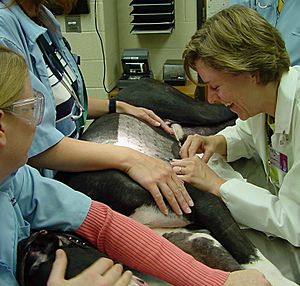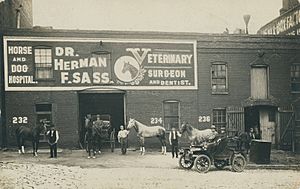Veterinarian facts for kids
A veterinarian (vet) is a medical professional who practices veterinary medicine. They manage a wide range of health conditions and injuries in non-human animals. Along with this, veterinarians also play a role in animal reproduction, health management, conservation, husbandry and breeding and preventive medicine like nutrition, vaccination and parasitic control.
Contents
Description
In many countries, the local nomenclature for a veterinarian is a regulated and protected term, meaning that members of the public without the prerequisite qualifications and/or license are not able to use the title. This title is selective in order to produce the most knowledgeable veterinarians that pass these qualifications. In many cases, the activities that may be undertaken by a veterinarian (such as treatment of illness or surgery in animals) are restricted only to those professionals who are registered as a veterinarian. For instance, in the United Kingdom, as in other jurisdictions, animal treatment may only be performed by registered veterinarians (with a few designated exceptions, such as paraveterinary workers), and it is illegal for any person who is not registered to call themselves a veterinarian, prescribe any drugs, or perform treatment.
Most veterinarians work in clinical settings, treating animals directly. These veterinarians may be involved in a general practice, treating animals of all types; they may be specialized in a specific group of animals such as companion animals, livestock, zoo animals or equines; or may specialize in a narrow medical discipline such as surgery, dermatology or internal medicine. As with other healthcare professionals, veterinarians face ethical decisions about the care of their patients. Current debates within the profession include the ethics of certain procedures believed to be purely cosmetic or unnecessary for behavioral issues, such as declawing of cats, docking of tails, cropping of ears and debarking on dogs.
Etymology and nomenclature
The word "veterinary" comes from the Latin veterinae meaning "working animals". "Veterinarian" was first used in print by Thomas Browne in 1646. Although "vet" is commonly used as an abbreviation in all English-speaking countries, the occupation is formally referred to as a veterinary surgeon in the United Kingdom and Ireland and now as a veterinarian in most of the rest of the English-speaking world.
History

Ancient Indian sage and veterinarian Shalihotra (mythological estimate c. 2350 BCE), the son of a sage, Hayagosha, is considered the founder of veterinary sciences.

The first veterinary college was founded in Lyon, France, in 1762 by Claude Bourgelat. According to Lupton, after observing the devastation being caused by cattle plague to the French herds, Bourgelat devoted his time to seeking out a remedy. This resulted in his founding a veterinary college in Lyon in 1761, from which establishment he dispatched students to combat the disease; in a short time, the plague was stayed and the health of stock restored, through the assistance rendered to agriculture by veterinary science and art.
The Odiham Agricultural Society was founded in 1783 in England to promote agriculture and industry, and played an important role in the foundation of the veterinary profession in Britain. A 1785 Society meeting resolved to "promote the study of Farriery upon rational scientific principles."
The professionalization of the veterinary trade was finally achieved in 1790, through the campaigning of Granville Penn, who persuaded the Frenchman Charles Vial de Sainbel to accept the professorship of the newly established Veterinary College in London. The Royal College of Veterinary Surgeons was established by royal charter in 1844.
Veterinary science came of age in the late 19th century, with notable contributions from Sir John McFadyean, credited by many as having been the founder of modern Veterinary research.
Roles and responsibilities
Veterinarians treat disease, disorder or injury in animals, which includes diagnosis, treatment and aftercare. The scope of practice, specialty and experience of the individual veterinarian will dictate exactly what interventions they perform, but most will perform surgery (of differing complexity).
Unlike in human medicine, veterinarians must rely primarily on clinical signs, as animals are unable to vocalize symptoms as a human would. In some cases, owners may be able to provide a medical history and the veterinarian can combine this information along with observations, and the results of pertinent diagnostic tests such as radiography, CT scans, MRI, blood tests, urinalysis and others.
As with human medicine, much veterinary work is concerned with prophylactic treatment, in order to prevent problems occurring in the future. Common interventions include vaccination against common animal illnesses, such as distemper or rabies, and dental prophylaxis to prevent or inhibit dental disease. This may also involve owner education so as to avoid future medical or behavioral issues.
Additionally, veterinarians can play important roles in public health and the prevention of zoonoses.
Employment
The majority of veterinarians are employed in private practice treating animals (75% of vets in the United States, according to the American Veterinary Medical Association).
Small animal veterinarians typically work in veterinary clinics, veterinary hospitals, or both. Large animal veterinarians often spend more time travelling to see their patients at the primary facilities which house them, such as zoos or farms.
Other employers include charities treating animals, colleges of veterinary medicine, research laboratories, animal food companies, and pharmaceutical companies. In many countries, the government may also be a major employer of veterinarians, such as the United States Department of Agriculture or the Animal and Plant Health Agency in the United Kingdom. State and local governments also employ veterinarians.
The COVID-19 pandemic has created a greater demand for veterinary services. Many people are home with extra time on their hands, and adoption agencies and animals shelters have seen a surge in pet purchases as a result. The American Veterinary Medical Association has provided COVID-19 resources for veterinarians on prevention measures, animal testing, and wellbeing.
Focus of practice
Veterinarians and their practices may be specialized in certain areas of veterinary medicine. Areas of focus include:
- Exotic animal veterinarian – Specializes in treating animals other than common pets and livestock. Includes reptiles, exotic birds such as parrots and cockatoos, and small mammals such as ferrets, rabbits, and chinchillas.
- Conservation medicine – The study of the relationship between animal and human health and environmental information.
- Small animal practice – Usually dogs, cats, and other companion animals/household pets such as hamsters and gerbils. Some practices are canine-only or feline-only practices.
- Laboratory animal practice – Some veterinarians work in a university or industrial laboratory and are responsible for the care and treatment of laboratory animals of any species (often involving bovines, porcine species, felines, canines, rodents, and even exotic animals). Their responsibility is not only for the health and well-being of the animals, but also for enforcing humane and ethical treatment of the animals in the facility.
- Large animal practice – Usually referring to veterinarians that work with, variously, livestock and other large farm animals, as well as equine species and large reptiles.
- Equine medicine – Some veterinarians are specialists in equine medicine. Horses are different in anatomy, physiology, pathology, pharmacology, and husbandry to other domestic species. Specialization in equine veterinary practice is something that is normally developed after qualification, even if students do have some interest before graduation.
- Food supply medicine – Some veterinarians deal exclusively or primarily with animals raised for food (such as meat, milk, and eggs). Livestock practitioners may deal with ovine (sheep), bovine (cattle) and porcine (swine) species; such veterinarians deal with management of herds, nutrition, reproduction, and minor field surgery. Dairy medicine practice focuses on dairy animals. Poultry medicine practice focuses on the health of flocks of poultry; the field often involves extensive training in pathology, epidemiology, and nutrition of birds. The veterinarian treats the flock and not the individual animals.
- Food safety practice – Veterinarians are employed by both the food industry and government agencies to advise on and monitor the handling, preparation, and storage of food in ways that prevent foodborne illness.
- Wildlife medicine – A relatively recent branch of veterinary medicine, focusing on wildlife. Wildlife medicine veterinarians may work with zoologists and conservation medicine practitioners and may also be called out to treat marine species such as sea otters, dolphins, or whales after a natural disaster or oil spill.
- Aquatic medicine – mostly refers to veterinary care of fish in aquaculture (like salmon, cod, among other species), but can also include care of aquatic mammals. For certain countries with high economic income from aquaculture, this is an important part of the veterinary field (like Norway, Chile). Other countries (particularly those which are landlocked), might have little or no emphasis on aquatic medicine.
- Dentistry – Many practices are incorporating dentistry into their daily medical services. Veterinary dentistry can extend the life of the patient by preventing oral disease and keeping the teeth and gums of the patient in healthy condition.
Images for kids
See also
 In Spanish: Medicina veterinaria para niños
In Spanish: Medicina veterinaria para niños





